February 2017
STAR Newsletter
February 2017 edition
Contents:- Quark Matter 2017 in a Flash!
- From the Spokesperson
- Software & Computing Update
- STAR Council News
- Evidence for Charm Quark Thermalization at RHIC
A note from the editor: as a collaboration-wide communication tool, this newsletter is set up to allow comments (subject to moderation against abuse), and all STAR Collaborators are welcome to do so! Please keep in mind that some content (including all comments) may be considered internal to the Collaboration and only accessible when logged into Drupal. Documentation is available here.
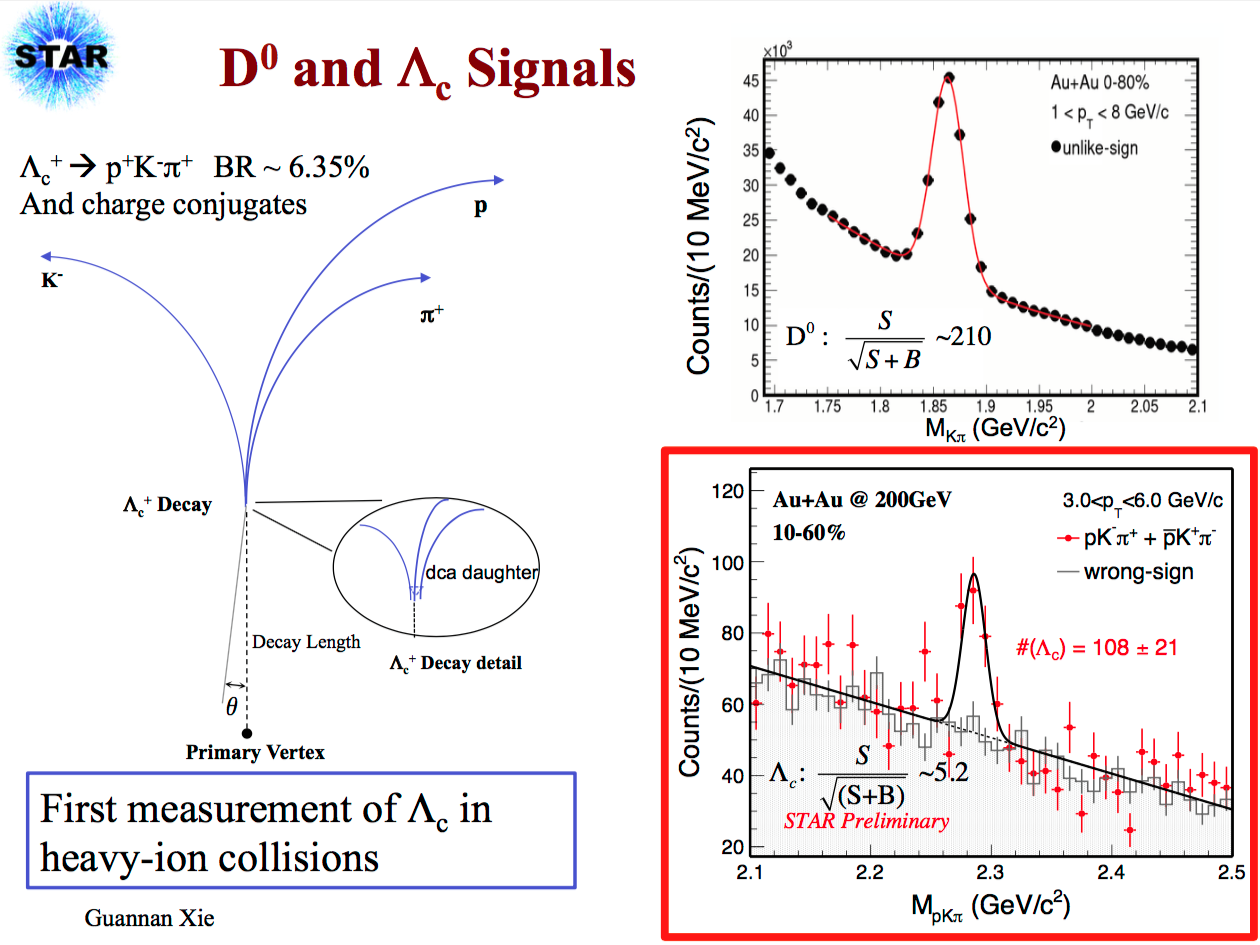
Figure 1. Highlight results plots that were shown, including the D0 and ΛC peaks from STAR.
(Guannan Xie - Student, USTC)
Quark Matter 2017 was the XXVIth international conference on ultrarelativistic heavy-ion collisions, held in Chicago from February 5th to February 11th, 2017. The focus of the discussions for this conference series is on fundamental understanding of strongly interacting matter at extreme conditions formed in ultrarelativistic heavy-ion collisions which relate to the state of the early universe.
During the conference, STAR had 19 talks (18 pre-scheduled talks + 1 flash talk) + 39 posters. And I am the lucky one who was selected for the flash talk!
My analysis mainly focuses on the ΛC reconstruction in Au+Au collisions at √sNN = 200 GeV using the STAR Heavy Flavor Tracker. ΛC is the lightest charmed baryon with a mass close to the D0 meson and has an extremely short lifetime (cτ ~ 60 μm) which makes it a most challenging measurement in heavy-ion collisions due to the huge combinatorial background. From our previous measurements in heavy-ion collisions, we observed an enhancement for the baryon-to-meson ratio in light hadrons and strange hadrons. Then a follow-up question is, "How about the baryon-to-meson ratio in heavy quarks, such as ΛC/D0?" Different models predict different levels of enhancement in the ΛC/D0 (baryon-to-meson) ratio depending on the degree of charm quark thermalization in the medium and how the coalescence mechanism is implemented. Actually, our result is the first measurement of ΛC in heavy-ion collisions and we observed a clear ΛC/D0 ratio enhancement compare to PYTHIA prediction. And the level of this ratio is similar to light-flavor hadrons.
Best Regards,
Guannan
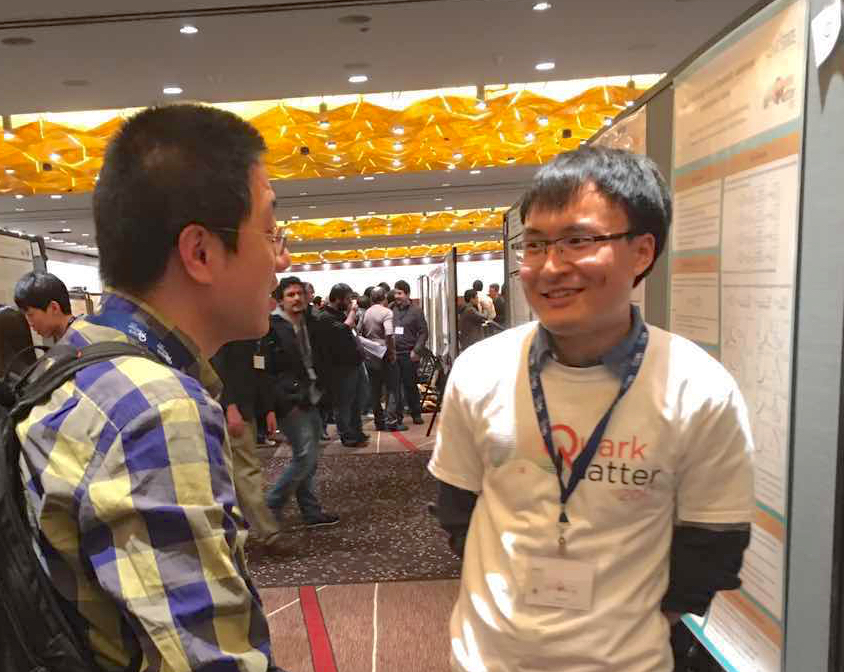
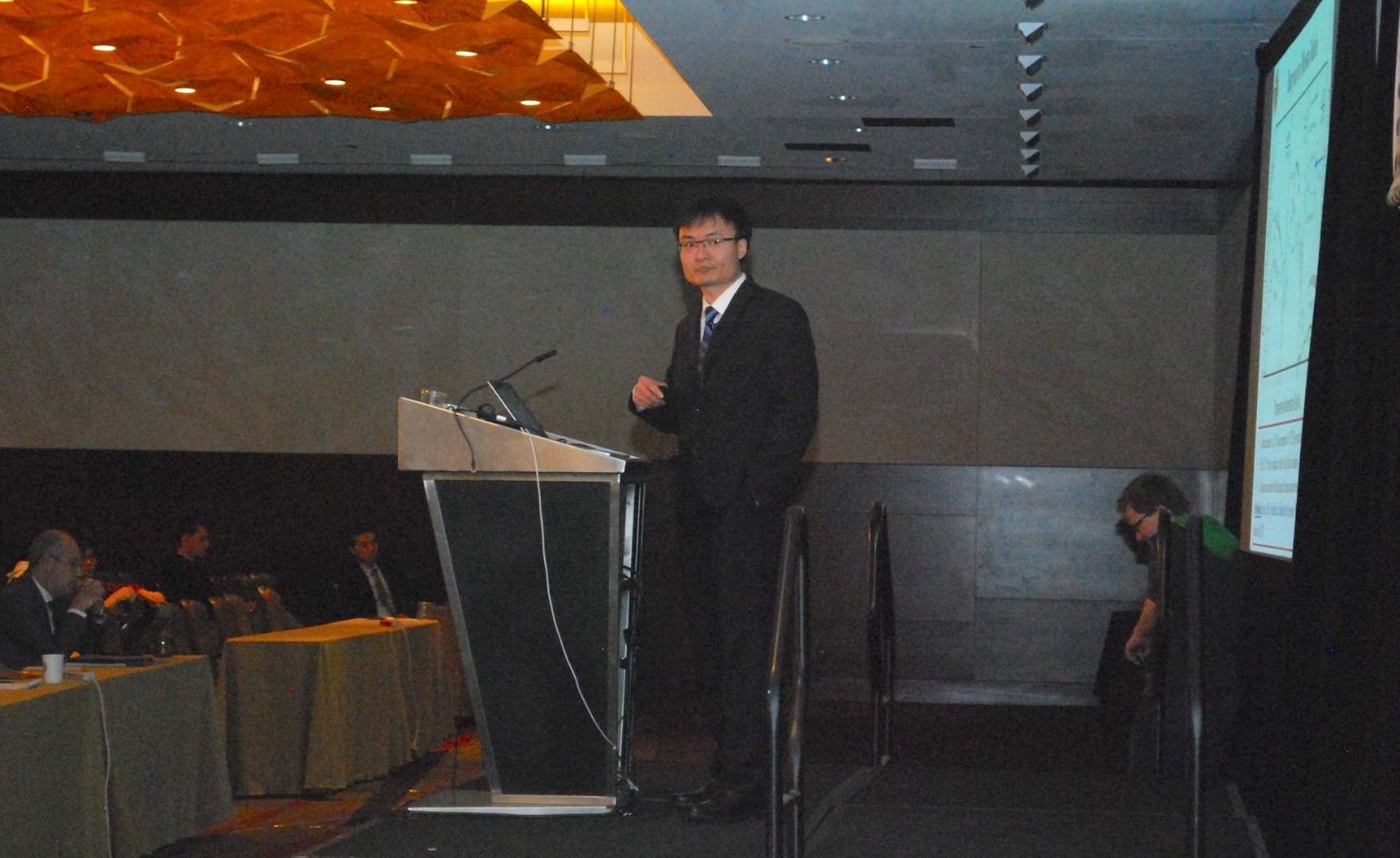
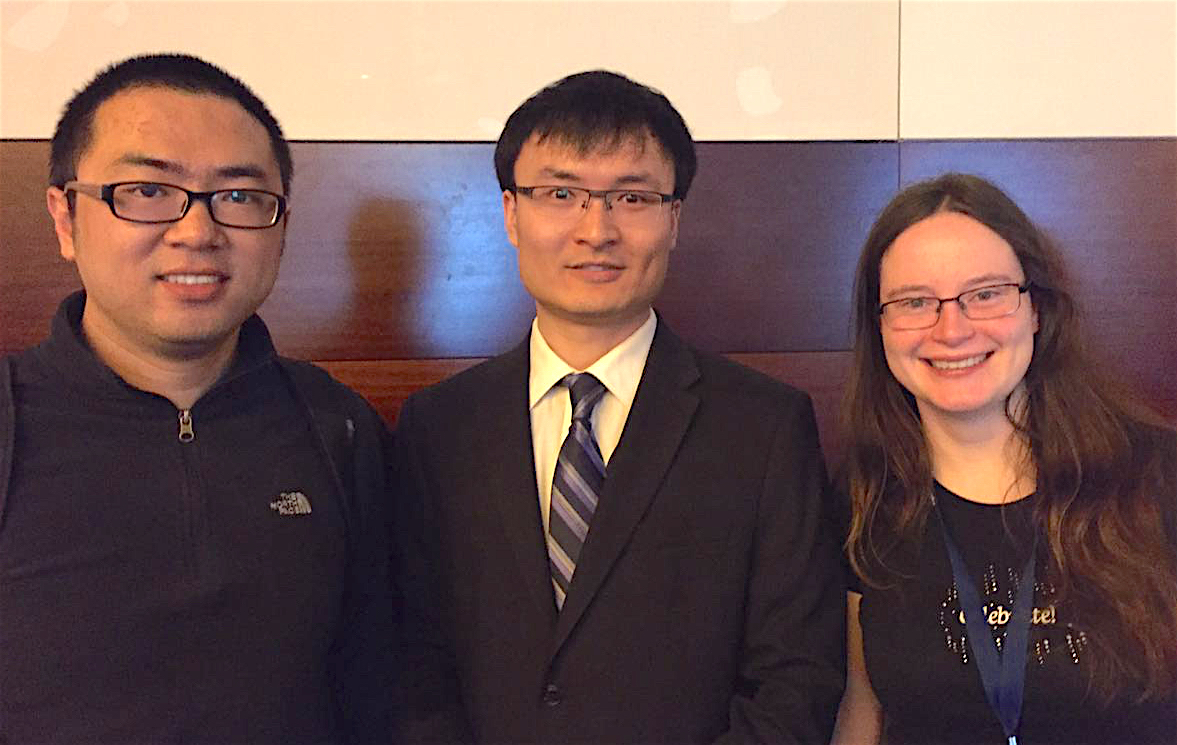
Figure 2. Several photos taken at QM2017. Left: During the poster section I discussed my poster with Xin Dong. Center: During my flash talk presentation. Right: A fun one, it's a group photo for the QM flash talkers from STAR including (left-to-right) Xu Sun (QM2014) + Guannan Xie (QM2017) + Kathryn Meehan (QM2015).
From the Spokesperson
(Zhangbu Xu - Spokesperson)
Dear Collaborators:
There have been two big events in February 2017: the beginning of RHIC Run 17 and the Quark Matter 2017 Conference in Chicago.
In addition to the news releases related to the conference by BNL and CERN, STAR has shown, just to name a few, the major discovery of Global Hyperon Polarization (Letter to NATURE under news embargo), the first observation of charmed baryons (ΛC) in heavy-ion collisions, new ways of probing the Chiral Magnetic Effect, separation of Υ states at RHIC, the systematic study of multiple harmonic correlations and flow, new BES-I results and fixed-target program, and different ways of studying reconstructed jets in heavy-ion collisions. A special congratulation goes to Guannan Xie, a student from USTC, who was awarded a plenary flash talk for the poster presentation on ΛC observation and enhancement in Au+Au collisions [see Guannan's contribution to this Newsletter]. The whole package (plenary preview talk, 17 parallel talks, 1 flash talk and 39 posters) represents an enormous amount of hard work from the entire Collaboration and those involved in the preparation (detector, software, analysis), presentation, vetting, and commenting. I would like to congratulate all the speakers and poster presenters who have represented our collaboration extremely well at this conference. Our talks and posters are available here, and pictures of all speakers are available here
Two weeks before the Quark Matter conference, we submitted 6 scientific papers for journal publications, which was about half of the average journal submissions per year. All the results (semi-inclusive jet, BES-I spectra, harmonic decomposition, D0 elliptic flow [see Xin's contribution to this Newsletter] and Global Hyperon Polarization) from those papers were highlighted by our speakers and other presenters throughout the Quark Matter conference.
Run 17 has started with the RHIC machine cool down on February 6th. We commissioned for a few days and physics data-taking was declared on February 24th. Our main physics goal is “Probing the "color" interactions among quarks tests a theoretical concept of nature's strongest force to pave a way toward mapping protons' 3D internal structure” with high-statistics of single spin asymmetries of W-boson, Forward Drell-Yan and direct photon measurements, a DOE milestone (HP13). New detector systems, which have been installed for Run 17 are: FMS poster shower detector, FMS UV radiation curing system, new QT boards for MTD, 1/8th of Event-Plane Detector, eTOF prototype modules, forward calorimeter prototype modules, and RHICf. The operation and computing teams have been preparing for this Run together with the subsystem experts (thank you!).
A call for the annual Beam Use Request (BUR) has been sent from the BNL ALD to RHIC collaborations on February 22nd, 2017:
Dear RHIC Spokespersons:
I am writing to request that you submit the annual Beam Use Request for the RHIC runs in 2018 and 2019 and related material.
We current[ly] anticipate, assuming favorable budget conditions, runs of 15 cryo-weeks (including 2 weeks for the Coherent electron Cooling test) in FY2018 and 24 cryo-weeks each in FY2019 and FY2020. Less favorable, but still likely, budget conditions would only allow for a combined run of 20 cryo-weeks in FY2019/FY2020. The beam use request should consider both possibilities.
The submissions are due by May 15, 2017. Since PHENIX has ended data taking and sPHENIX has not yet started construction, I expect to receive a BUR from STAR only.
I also ask STAR and PHENIX to report on the status of analyses of data from previous RHIC runs, especially the runs in 2014-16.
In addition, I invite the STAR and sPHENIX Collaborations to present letters of intent for proposals of modest forward upgrades to their detectors for data taking after 2021 for consideration by the PAC.
The dates for this year’s RHIC PAC meeting are June 15-16, 2017. A list of current PAC members is attached for your information.
Thanks in advance,
Berndt
In the next weeks, we will assemble a BUR writing committee and a review committee for the Forward Upgrade proposal. The goal is to provide convincing scientific arguments for isobar collisions in Run 18, and strong programs for BES-II and the Cold QCD plan.I am writing to request that you submit the annual Beam Use Request for the RHIC runs in 2018 and 2019 and related material.
We current[ly] anticipate, assuming favorable budget conditions, runs of 15 cryo-weeks (including 2 weeks for the Coherent electron Cooling test) in FY2018 and 24 cryo-weeks each in FY2019 and FY2020. Less favorable, but still likely, budget conditions would only allow for a combined run of 20 cryo-weeks in FY2019/FY2020. The beam use request should consider both possibilities.
The submissions are due by May 15, 2017. Since PHENIX has ended data taking and sPHENIX has not yet started construction, I expect to receive a BUR from STAR only.
I also ask STAR and PHENIX to report on the status of analyses of data from previous RHIC runs, especially the runs in 2014-16.
In addition, I invite the STAR and sPHENIX Collaborations to present letters of intent for proposals of modest forward upgrades to their detectors for data taking after 2021 for consideration by the PAC.
The dates for this year’s RHIC PAC meeting are June 15-16, 2017. A list of current PAC members is attached for your information.
Thanks in advance,
Berndt
Sincerely,
Zhangbu Xu
Software & Computing Update
(Jérôme Lauret - S&C Leader)
Near the end of February, the S&C Team management met with the PWGCs for the second "PWGC / S&C Exchange meeting". The discussion was productive and we covered lots of ground, including progress and status since the last meeting we held, an overall status of data production, recent developments in tracking and vertex-finding, as well as the potential to run a massive data production on NERSC/Cori as part of the recently acquired 25 million hours allocation. We also asked of the PWGCs to prepare a new data production plan and review the datasets on distributed disks.
Figure 3. Data transfer rate test results from BNL to NERSC.
For the NERSC/Cori exercise, we are also in the process of upgrading and tuning our grid gatekeeper infrastructure. At this point, the data transfer rate tests from BNL to NERSC seems to show a performance above 600 MB/sec (see Fig. 3). We are working with our NERSC colleague to understand the link speed in the reverse direction (which is not symetrical). In all cases, the good news is that the transfer rate is above requirement needs and we should be in good shape to re-start the full end-to-end production workflow.
Now that Run 17 is in full ramp-up, many members of the team are also focused and shifting attention to its support. All databse daemons and information gathering processes were restored and FastOffline plus automated QA & calibrations resumed. We wish all a productive shift and as usual, if there are Run-related problems, please use the rts Hypernews forum for communication.
STAR Council News

The STAR Council is called to deal with general collaboration issues, such as organizing collaboration governance (through bylaw adoption or amendments), establishing and overseeing publication policies, admission of new Institutional members, etc. Another important responsibility of the STAR Council is the election of the STAR Spokesperson. The Spokesperson, elected for a nominal term of 3 years, carries major responsibilities within the Collaboration in terms of scientific, technical and managerial concerns, ensuring efficient operations of the experiment, facilitating detector upgrades, as well as disseminating STAR’s physics results in the timeliest fashion possible.
Needleless to say, the Council takes election matters very seriously and currently is preparing to run the next Spokesperson election at the upcoming Collaboration meeting at BNL during the week of May 15th-20th, 2017. Following the procedures prescribed by the Collaboration bylaws, I have established a nomination committee for this election, and the STAR Council has approved it. The nomination committee, consisting of Michael Cherney, Flemming Videbaek, Jaroslav Bielcik, and myself, is now seeking candidates and soliciting nominations for the Spokesperson position. The voting procedures for this election were set forth in accordance with STAR bylaws, and are effectively unchanged from what was used in the last election three years ago.
There is one new proposal in connection with the Spokesperson election, which is currently under Council deliberation. A modification to our bylaws was proposed by two STAR member Institutions to allow a team of two people to seek election for the office as co-Spokespeople. The proponents of this proposal argue that such a change, tested by other RHIC collaborations, could bring in the advantage of a combined skill set, while alleviating individual obligation constraints, thus enabling a more effective operation as well as broadening the potential candidate pool. The issues that are now carefully being weighted in this Council discussion are whether current management structure has some deficiencies or if similar advantages could be achieved through delegation of power. Also under consideration are the potential impacts on several aspects of publication policy, which currently cites a single Spokesperson as the final authority.
I will keep you updated on these developments. Sincerely,
Olga Evdokimov
Evidence for Charm Quark Thermalization at RHIC
(Xin Dong - LBNL)
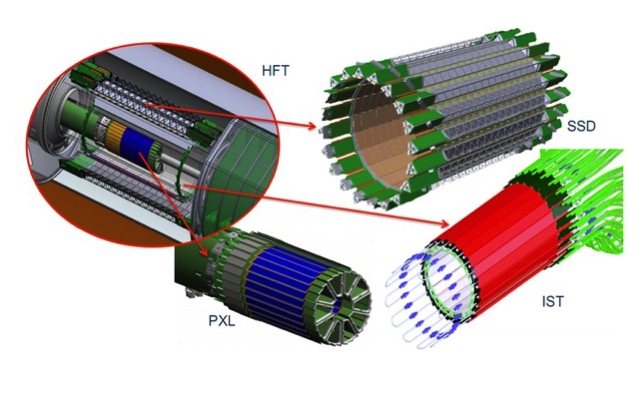

Figure 4. Left: The Heavy Flavor Tracker (HFT) system which consists of one layer of Silicon Strip Detector (SSD), one layer of Intermediate Silicon Tracker (IST), and two layers of PiXeL detector (PXL). Right: Pointing resolution in the transverse plane as a function of particle momentum (or transverse momentum) at mid-rapidity from experiments at RHIC and the LHC.
Heavy flavor quarks, due to their large masses, are considered to offer unique information about QGP dynamics in heavy-ion collisions. A measurement of heavy flavor hadron v2, particularly in the low-to-intermediate pT region, will provide us a better understanding of medium thermalization, and can help quantitatively measure the heavy quark diffusion coefficient – one of the intrinsic transport parameters of the QGP.
The HFT consists of three subsystems: one layer of Silicon Strip Detector (SSD), one layer of Intermediate Silicon Tracker (IST) and two layers of silicon PiXeL (PXL) detectors. The HFT-PXL detector is the first application of the MAPS technology in a collider experiment. Its unique features include fine pixel size and thin material budget which provides superior track pointing resolution for charged particles over a broad momentum range. The HFT was designed for precision measurements of charmed hadron production via topological reconstruction of displaced vertices in heavy-ion collisions. The HFT was installed and taken physics data during RHIC Runs 2014-2016. The dataset used in the PRL was about 1.1B minimum-bias-triggered Au+Au 200 GeV events taken in 2014. Fig. 4 (right) shows the track pointing resolution in the transverse plane as a function of particle momentum (or transverse momentum) at mid-rapidity from experiments at RHIC and the LHC.
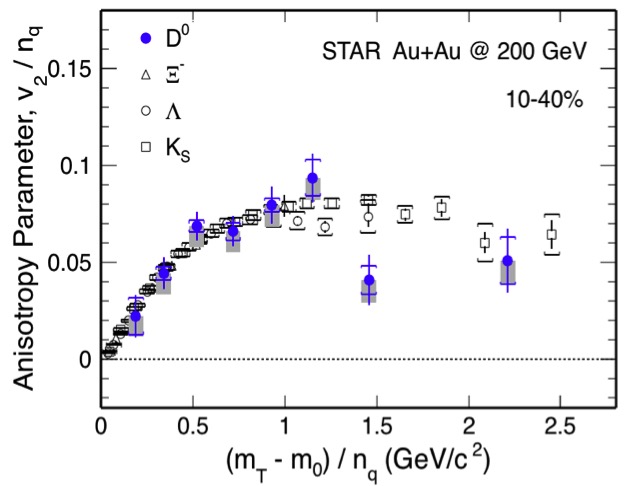

Figure 5. Left: v2 normalized by the number-of-constituent-quarks (nq) as a function of transverse kinetic energy (also normalized by nq) for D0 mesons and light hadrons in 10-40% central Au+Au collisions at 200 GeV. Right: v2 as a function of pT for D0 in 0-80% Au+Au collisions at 200 GeV compared to various model calculations.
Fig. 5 (right) shows the D-meson v2 compared to various theoretical model calculations. One interesting observation is that the measured D-meson v2 can be well-described by a 3D viscous hydrodynamic model calculation, which indicates that charm quarks may have reached local thermal equilibrium. The precision of the current data allows us to distinguish different models but there are non-trivial differences between different models that need to be settled. One important physics goal, for the future, is to constrain the temperature dependence of the heavy quark diffusion coefficient parameter via joint investigations between theorists and experimentalists.
The D0 v2 results, together with other heavy flavor results from STAR (e.g. the enhancement observed in the Ds and ΛC production in mid-central Au+Au collisions as well as the charm/bottom-separated single-electron RAA measurements) have been reported and highlighted in the recent Quark Matter 2017 conference in Chicago in February [see Guannan's contribution to this Newsletter]. These measurements strongly suggest that charm quarks may have reached thermalization in the Au+Au collisions at RHIC energy.
The paper was made possible with significant contributions from colleagues at BNL, CCNU, KSU, LBNL, MIT, Purdue, SINAP, UIC, USTC, and UT Austin, with critical support from the STAR operation and computing teams as well as the paper's GPC.
Previous Edition: December 2016
Groups:
- Printer-friendly version
- Login or register to post comments
